 Kat Hing Wai and Lok Ma Chau |
|||
 Kat Hing Wai and Lok Ma Chau |
|||
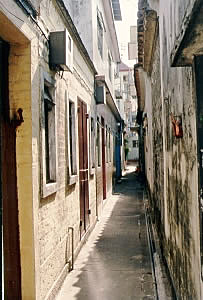 |
Our next stop was the walled village of Kat Hing Wai. This village dates to the 1600's when it was built as a fortress for the Tang clan. The Tangs were some of the first inhabitants of the region when them moved from central and southern China over 800 years ago. Today the villagers farm the adjacent land and rice fields The village with its protective walls and moat stand as a reminder of a typical Cantonese village of several hundred years ago when walls were needed to protect the inhabitants from the bandits that roamed the area. << A narrow passageway of the walled city. Ken exploring one of the passageways of Kat Hing Wai. |
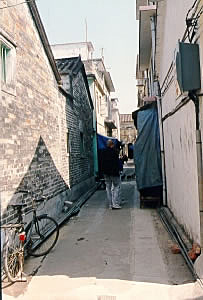 |
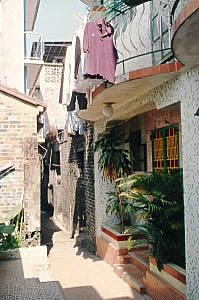 |
<< In today's walled city some of the apartments had balconies with wrought iron fencing which was appropriately put to good use to dry the day's laundry. As you walk through the village many of the doorways >> into the homes were opened for the visitors to peer into. In this one home we found a brightly colored and decorated altar occupying a predominant area of the room. |
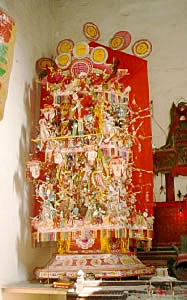 |
| One of the highlights of visiting the walled villages is the opportunity to photograph the Hakka women wearing their broad brim hats. They will gladly oblige your photo requests for a small fee which you can bargain for before taking the photo. They are a bit adamant about the fee at times. For example, I bargained with the four women at the right and took several pictures. While I was taking my pictures Darla walked up and took a picture totally unaware of the bargaining. When I paid them I figured it covered the both of us, but they immediately pursued Darla to extract their fee from her also. It was really unimportant as the fee is small and the pictures are certainly worth the small price. | 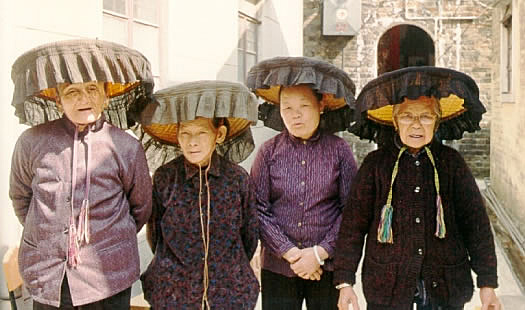 |
|
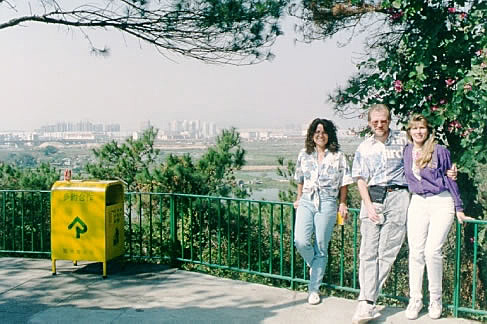 |
Leaving Kat Hing Wai we proceeded to Lau Fau Shan, a small fishing village. There wasn't much there so I didn't bother to take any photographs. Our next stop, Lok Ma Chau, would be much more interesting. Lok Ma Chau is situated just south of the Sham Chun River that separates the New Territories from mainland China. It offers an excellent view across of mainland China from its high vantage point. |
| Anne, Ken and Darla at Lok Ma Chau |
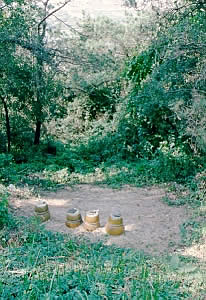 |
<< Standing at the overlook on Lok Ma Chau we noticed several clay pots in the soil down below. When we asked our driver what they were we were told that they contained the ashes of the departed who died and could not be returned to mainland China. A Hakka woman at Lok Ma Chau. She was >> persistent and wanted us to take her picture. She followed us for quite sometime before I paid her the HK$1 she demanded. I think the picture was worth the few pennies it cost. |
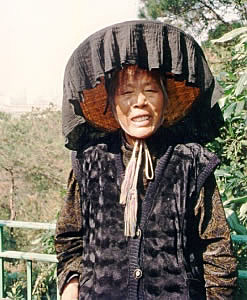 |
| Ken, Darla and Anne enjoying a refreshment at Lok Ma Chau before heading back to Kowloon and our next stop ... The shopping district of Kowloon |
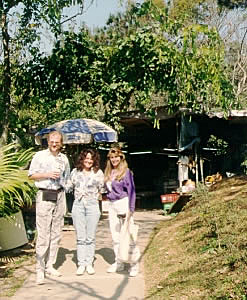 |